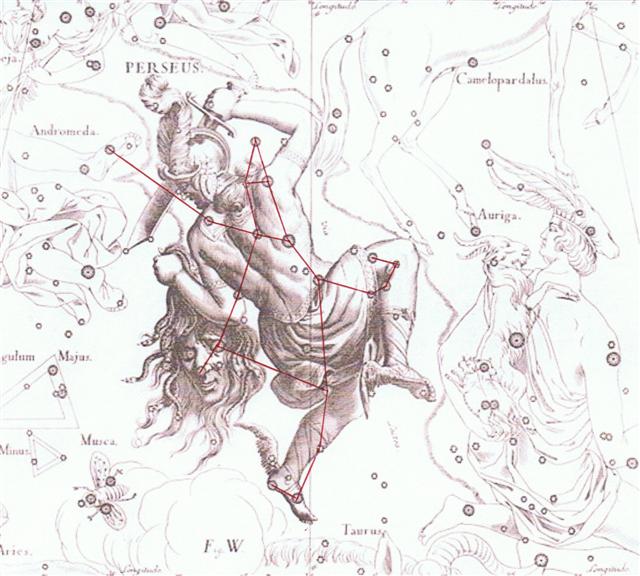Counted from January 1 day 314 is November 10. And 348 (side b) - 24 = 324 (= 12 * 27):
Nusakan (β Corona Borealis) rose 184 days after Algenib Persei (= 181 days before Algenib Persei). And in rongorongo times Nusakan rose with the Sun in RA day 234 (= 18 * 13). It appears to be necessary to combine numbers and glyphs in order to find the structures of the rongorongo texts:
740 (side a + side b) - 324 = 416 = 16 * 26. April 17 (107) - March 22 (81) = 26. Heliacal Algenib Persei (α) may once have indicated the return of the Sun. In the drawing of Hevelius the right side of Perseus is illuminated and at left (in the past) is the severed head of the Medusa (probably a personification of winter). Gienah (the very bright γ in the black Raven constellation) culminated at midnight in May 10 and this could have been regarded as another Sign of how winter was 'decapitated'.
South of the equator the corresponding time would have been the Gregorian π day (November 10, 314) when Algenib Persei could be see close to the Full Moon. Metoro said ma te ua which could mean 'with rain'. The Arabs regarded the season of spring rains as a lucky time, because these would enable the earth to once again bring forth fresh grass. ... The earth rises up from the sea again, and is green and beautiful and things grow without sowing. Vidar and Vali are alive, for neither the sea nor the flames of Surt have hurt them and they dwell on the Eddyfield, where once stood Asgard. There come also the sons of Thor, Modi and Magni, and bring along his hammer. There come also Balder and Hoder from the other world. All sit down and converse together. They rehearse their runes and talk of events of old days. Then they find in the grass the golden tablets that the Aesir once played with ... | ||||||||||||||||||||||||||||||||||||||||||||||||||||||||||||||||||||||||||||||||||||||||||||||||||||||||


